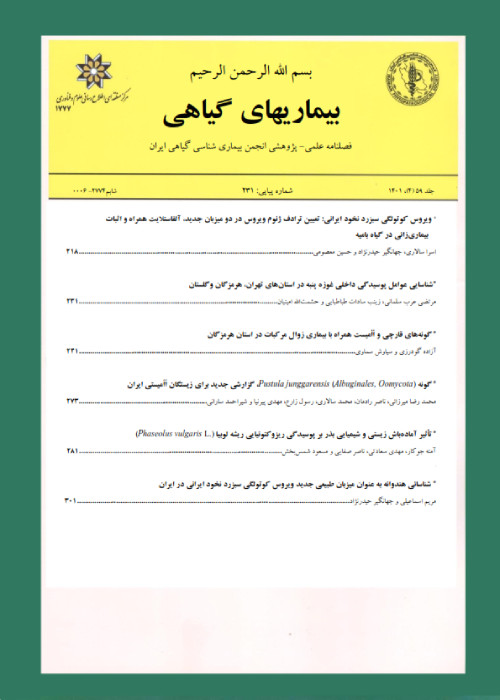NOVEL ISOLATE OF Spiroplasma citri FROM LEAFHOPPER Circulifer haematoceps FROM FARS PROVINCE
Abstract:
Strains of Spiroplasma citri have been classified into five groups based on electrophoretic mobility (EM) of spiralin protein and RFLP analysis of spiralin gene (Foissac et al. 1996). In the present study, two isolates of S. citri qualifying for formation of a sixth group are reported. Infection of sesame plants by S. citri has been reported previously (Salehi and Izadpanah 2002). Samples of vector (Circulifer haematoceps) leafhoppers (Salehi et al.1993) were collected in various regions in Fars province of Iran. The insects were caged on periwinkle (Catharanthus roseus) plants. Presence of S. citri in collected plant samples and vector-inoculated plants was verified by ELISA using a locally produced polyclonal antiserum against a citrus isolate of S. citri. ELISA-positive samples were used to isolate S. citri in culture medium LD10 (Lee and Davis 1984). S. citri grown in culture was used to amplify spiralin gene by PCR using specific primer pair F1/R1 (5´ -TAATTTTAATAACATTTGCTT-3´/5-´ GTTCTAAATAAGAAAAAGTTT-3´). The amplified products were cloned in E. coli and sequenced. RFLP analysis showed that most isolates fell into group I of S. citri strains but two isolates originally obtained from C. haematoceps in a sesame field and propagated in periwinkle (Catharanthus roseus) did not match any of the five groups. The spiralin gene in both isolates (Acc. No. FJ755921 and FJ755922.) had only 93 percent homology with that of GII3 strain and could code for 244 amino acids (aa) instead of 241 aa in strains of groups 1-4 and 242 aa in a group 5 (Palmyre) strain. RFLP analysis showed that the leafhopper isolates had one additional MboI restriction site at nucleotide 456 plus changes in the position of certain other restriction sites. These results were confirmed by electrophoresis in polyacrylamide gel in which the spiralin protein from both insect isolates showed a different EM and banded at 28.8 kDa compared to 32 kDa for palmyre isolate and 24-28.5 reported for groups 1-4. By the current criteria (Foissac et al. 1996) the two new isolates qualify for forming a new group (group 6) of S. citri strains from Iran.
Language:
Persian
Published:
Iranian Journal of Plant Pathology, Volume:46 Issue: 3, 2010
Page:
281
magiran.com/p805364
دانلود و مطالعه متن این مقاله با یکی از روشهای زیر امکان پذیر است:
اشتراک شخصی
با عضویت و پرداخت آنلاین حق اشتراک یکساله به مبلغ 1,390,000ريال میتوانید 70 عنوان مطلب دانلود کنید!
اشتراک سازمانی
به کتابخانه دانشگاه یا محل کار خود پیشنهاد کنید تا اشتراک سازمانی این پایگاه را برای دسترسی نامحدود همه کاربران به متن مطالب تهیه نمایند!
توجه!
- حق عضویت دریافتی صرف حمایت از نشریات عضو و نگهداری، تکمیل و توسعه مگیران میشود.
- پرداخت حق اشتراک و دانلود مقالات اجازه بازنشر آن در سایر رسانههای چاپی و دیجیتال را به کاربر نمیدهد.
In order to view content subscription is required
Personal subscription
Subscribe magiran.com for 70 € euros via PayPal and download 70 articles during a year.
Organization subscription
Please contact us to subscribe your university or library for unlimited access!


